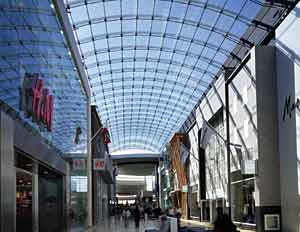Strengthening the Performance of Laminated Glass
The design team cited four reasons for using the material. First, the structural integrity provides high rigidity and strength of the stiff interlayer. Second, the interlayer demonstrated no edge delamination after many years of exposure to very humid conditions. Third, the structural interlayer provided an effective ultraviolet (UV) barrier that prevents the aging and discoloration of fabrics and fibers. Lastly, laminated glass provided the optimum light transmission of any material tested.
The structural interlayer provides the necessary additional strength required to accommodate the dominant bending stresses in the construction. The glass construction is 12 mm heat-soaked fully-tempered glass + 1.52 mm structural interlayer + 0.5 mm perforated metal sheet + 1.52 mm structural interlayer + 15 heat-soaked fully tempered glass. The polymer flowed well during laminating, allowing it to completely fill in the holes in the metal mesh. The panel design was minimally supported and attached to one glass ply only, which allowed for a smooth outer glass skin. Most importantly, the structural properties of the interlayer allow the thinnest, strongest design of such a laminate.
According to Andreu, functionally and visually, the space links the auditoriums to the city, which are visible from the surrounding landscape.
Snowy loads
A structural interlayer was essential to bringing light into the Yorkdale Shopping Centre [Figure 3, Figure 4]. Originally built in 1964, the mall was once the largest enclosed shopping center in the world, but after 2000, it needed an upgrade. MMC International Architects Ltd. of Toronto renovated the mall with the addition of a 60-foot-high, barrel-vaulted atrium of laminated glass, running 300 feet in length, and soaring above an 180,000-square-foot portion of the mall. The architect wanted to create an uncluttered sense of being outside.
|
Without the structural interlayer, a heavier steel truss or membrane support system would have been required, that would have altered the design concept.
"This application required laminated glass due to the fact that the glass is an overhead application," said John Kooymans, a structural engineer at the engineering firm Halcrow Yolles, based in Toronto and London. "The code requires the glazing design incorporate a provision for preventing broken glass from falling. Laminating the glass is the preferred method when transparency is critical in the design application."
The laminated glass used in the mall contains a structural interlayer that is roughly 35 percent thinner and lighter than other laminated glass, including those made with traditional PVB. While thinner and lighter, it still perseveres through Toronto's harsh climate of freezing winter temperatures that often fall below negative 20 degrees centigrade, and continuous months of thick, heavy ice and snow.
The snow load specification was 65 lbs. per square foot. The structural interlayer demonstrated excellent edge stability, which helps the glass construction to bear heavier loads at the sides, where the barrel-vaulted roof meets the walls, and where the glass construction needs to be strongest. In addition, the structural interlayer offers better long-term edge performance. The overall glass construction is thinner, more affordable and more transparent.










